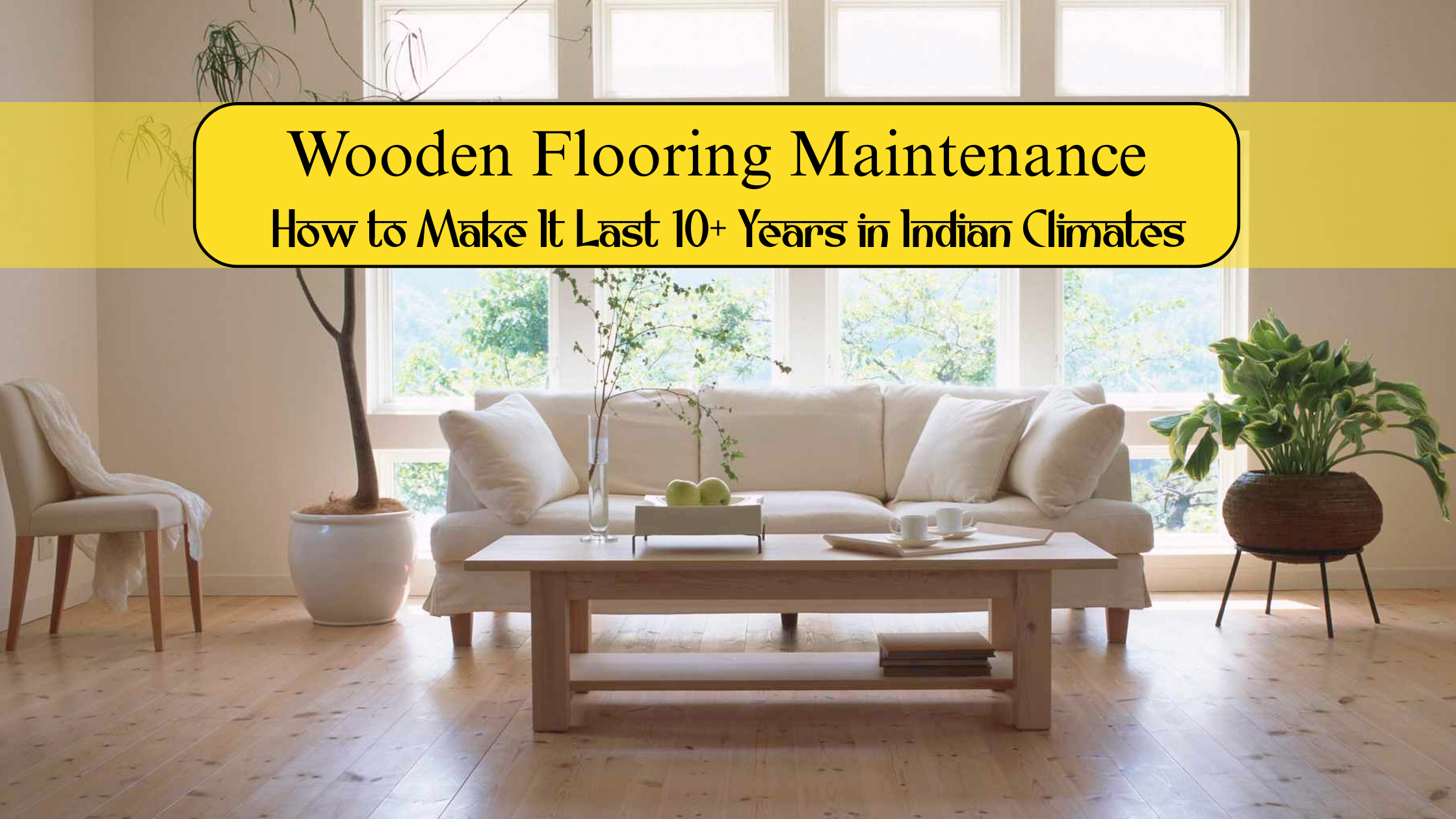Wooden flooring give a room a warm, refined, and beautiful vibe. But because of India’s harsh environment, which includes variations in humidity, heat from the sun, and monsoon rains, wood can rot, swell, or die if it is not stored properly.
If you already have wooden flooring installed (or plan to get it via our wooden flooring installation service), this guide will help you preserve it for the long haul.
Why Indian Climates Are Tough on Wood
Before diving into tips, let’s understand what your floor is up against:
- High humidity & monsoon moisture cause wood to absorb water, expand or cup.
- Heat & dry weather seasons dry out the wood and shrink with gaps or cracks.
- Day & night temperature fluctuations aggravate expansion & contraction cycles.
- Extended periods of sunlight can bleach surface finishes.
- Dirt, dust, and grit that are brought in can scratch the finish.
Due to these stresses, proper installation is essential. We at Theinstallers ensure:
- Appropriate acclimatization of planks before laying
- Proper expansion gaps
- Use of quality finishes that resist moisture and UV
- Expert techniques to avoid installation flaws
Once installed well, your role is to maintain it smartly.
Key Maintenance Practices to Make Wood Flooring Last 10+ Years
Here’s a breakdown of what to do — daily, monthly, seasonally — mixed with bullet points and paragraphs so it’s easy to read.
1. Keep Indoor Humidity within the Safe Zone (35% – 55%)
- Use air conditioners, dehumidifiers, or exhaust fans in rainy seasons.
- Close windows or gaps between doors through which wet air might leak in.
- Avoid sudden shifts — e.g., leaving a wet outside door open into air-conditioned areas suddenly.
- If the air inside gets too dry during dry times, use a humidifier to keep the wood from drying out too much.
- Why it matters: The main reason wood warps and splits is because it doesn’t get enough moisture.
2. Clean Delicately and Regularly
- To prevent damage to the finish, dust, grit, and detritus can be removed by vacuuming or sweeping with a gentle brush on a daily or bi-frequent basis.
- Once per week, utilize either a microfiber mop or a soft, saturated fabric. The floor should constantly be rung out nicely; avoid overwatering it.
- Soda, water, or juice spills must be immediately cleaned up using a cloth that has been dampened lightly and dried.
- Do not use steam mops, harsh cleaners, or too much water on the floor because these will pollute the wood below by seeping into seams.
- It is recommended to use wood floor cleaning solutions for this purpose or weak pH-neutral cleaners.
3. Manage Sunlight & UV Exposure
- To shield direct sunlight that hits the wood surface, employ shades, drapes, or UV-cut window films.
- To keep one part from fading relative to another, rotate the rugs and furnishings every now and then.
- Avoid having heavy objects permanently placed in a position where the sun can whiten the ambient wood.
4. Save Scratches & Pressure Marks
- Use mats at doors to trap dirt, raindrops, or pebbles before they reach the wood.
- Position felt pads or soft glides beneath furniture legs (bedstands, wardrobes, chairs).
- Don’t pull heavy furniture — lift or slide with appropriate protection underneath (e.g. a blanket).
5. Refinish, Polish & Restore Periodically
- Your floor will need to be refinished every 7 to 10 years, or whenever the finish starts to wear off, depending on the type of wood and the finish.
- If you can sand your wood, lightly sand it before putting on additional coatings of protection, including water-based varnish or polyurethane.
- Also, lightly “top-up” polish annually to maintain the gloss — but don’t overload with waxy polishes that leave a cloudy coating.
6. Seasonal Inspections & Minor Repairs
- During monsoon, inspect for edging swelling or evidence of water intrusion in corners.
- In dry seasons, check gaps or cupping between boards and let wood breathe.
- Secure loose boards, touch in small cracks or splits with color-matched wood filler.
- Check baseboards and expansion gaps; ensure they are not clogged by dust or debris inhibiting natural expansion.
Additional Tips & Warnings
- During the monsoon, steer clear of wet shoes and wet matting on wood floors.
- Use water-resistant trays to prevent water from potted plants from spilling onto wood.
- Only follow the wood supplier’s recommendations when using oil soaps, harsh chemicals, or wax cleansers.
- Be careful of humidity even when using air conditioners or humidifiers to avoid going overboard.
- Rugs can be used in pet areas, and pets’ nails should be kept clipped.
- Avoid big rolling loads without protection boards underneath, such as wheeled carts or bags.
- Why Most Wood Floors Break Too Soon (and How to Stop It)
- Buckling happens because of bad initial installation, including not leaving enough room for expansion or not letting the wood become used to the climate.
- Ignoring humidity control — allowing moisture or dryness to get out of hand.
- Applying harsh cleaners or too much water, which assaults the finish and the wood core.
- Ignoring minor damage (small scratches or cracks) that grow into bigger problems.
At TheInstallers, our wooden flooring installation team ensures those initial mistakes do not happen — correct laying, acclimatizing wood, expansion spacing, and high-quality finishing.
Final Thoughts
With a little bit of TLC and the right habits, your wooden floors can be excellent and last far more than a decade — even under India’s harsh climate conditions. The key is consistency, soft care, and surveillance.When in doubt — want a consultation, refinishing, or professional maintenance — reach out to our wooden flooring services team at TheInstallers. We’ll help keep your floor beautiful, stable, and worry-free for years.

